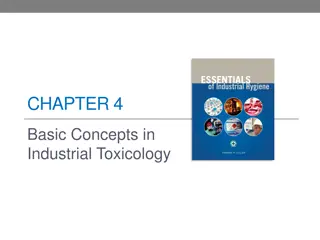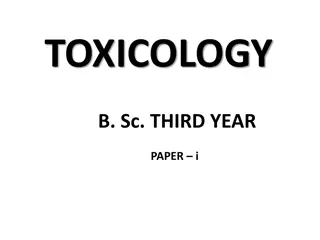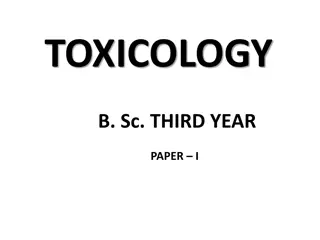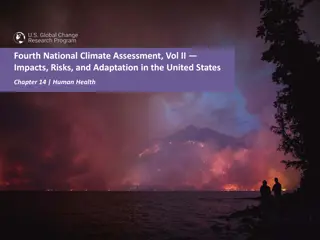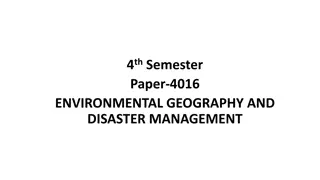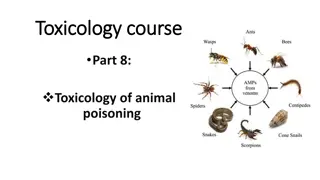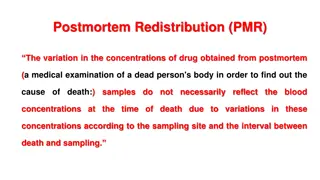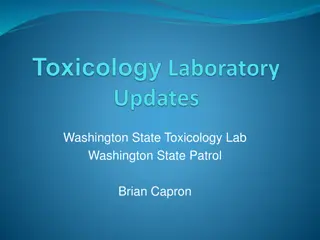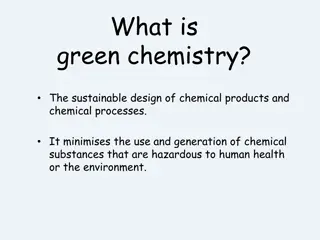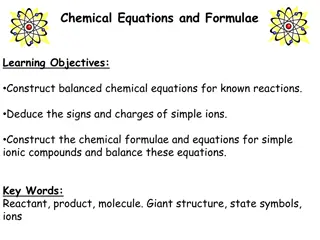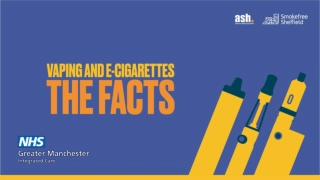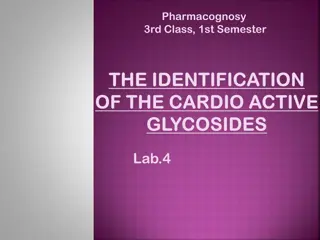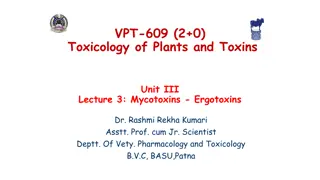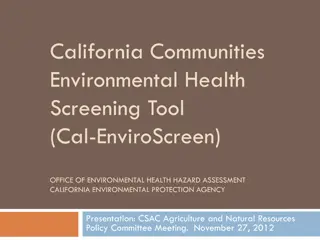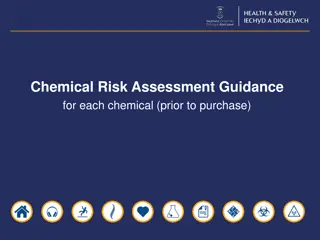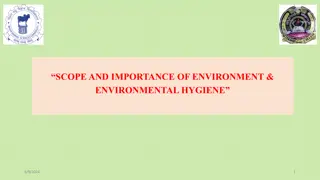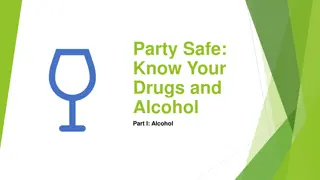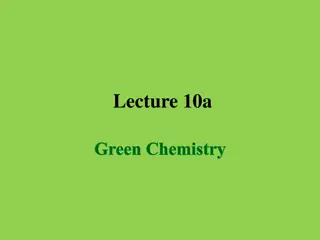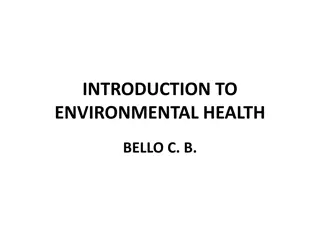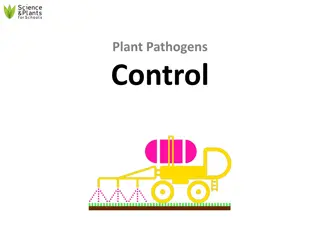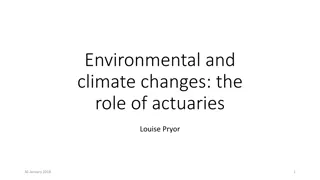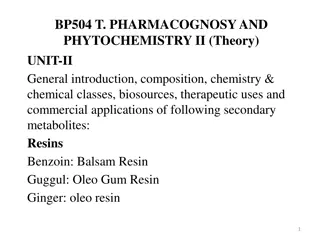Overview of Toxicology: Understanding Chemical Risks and Health Impacts
Toxicology is a crucial field that assesses the effects of various toxic substances on human health and the environment. From heavy metals to solvents, radiation, pesticides, and animal toxins, this discipline plays a vital role in identifying and managing risks associated with exposure to harmful chemicals. Understanding the classification of toxic substances and their impact on individuals is essential for safeguarding public health and environmental well-being.
Download Presentation

Please find below an Image/Link to download the presentation.
The content on the website is provided AS IS for your information and personal use only. It may not be sold, licensed, or shared on other websites without obtaining consent from the author. Download presentation by click this link. If you encounter any issues during the download, it is possible that the publisher has removed the file from their server.
E N D
Presentation Transcript
TOXICOLOGY UNIT ii
INTRODUCTION Toxicology addresses a variety of questions. For example, in agriculture, toxicology determines the possible health effects from exposure to pesticides or herbicides, or the effect of animal feed additives, such as growth factors, on people. Toxicology is also used in laboratory experiments on animals to establish dose-response relationships. Toxicology also deals with the way chemicals and waste products affect the health of an individual. Toxic substances are classified into the following: A. Heavy Metals-Metals differ from other toxic substances in that they are neither created nor destroyed by humans. Their use by humans plays an important role in determining their potential for health effects. Their effect on health could occur through at least two mechanisms: first, by increasing the presence of heavy metals in air, water, soil, and food, and second, by changing the structure of the chemical. For example, chromium III can be converted to or from chromium VI, the more toxic form of the metal.
B. Solvents and Vapors Nearly everyone is exposed to solvents. Occupational exposures can range from the use of white-out by administrative personnel, to the use of chemicals by technicians in a nail salon. When a solvent evaporates, the vapors may also pose a threat to the exposed population. C. Radiation and Radioactive Materials Radiation is the release and propagation of energy in space or through a material medium in the form of waves, the transfer of heat or light by waves of energy, or the stream of particles from a nuclear reactor D. Dioxin/Furans Dioxin, (or TCDD) was originally discovered as a contaminant in the herbicide Agent Orange. Dioxin is also a by-product of chlorine processing in paper producing industries.
E. Pesticides The EPA defines pesticide as any substance or mixture of substances intended to prevent, destroy, repel, or mitigate any pest. Pesticides may also be described as any physical, chemical, or biological agent that will kill an undesirable plant or animal pest G. Animal Toxins These toxins can result from venomous or poisonous animal releases. Venomous animals are usually defined as those that are capable of producing a poison in a highly developed gland or group of cells, and can deliver that toxin through biting or stinging. Poisonous animals are generally regarded as those whose tissues, either in part or in their whole, are toxic.
Animal Toxins Some species from practically all phyla of animals produce toxins for either offensive or defensive purposes. Some are passively venomous, often following inadvertent ingestion, whereas others are actively venomous, injecting poisons through specially adapted stings or mouthparts. It may be more appropriate to refer to the latter group only as venomous and to refer to the former simply as poisonous. The chemistry of animal toxins extends from enzymes and neurotoxic and cardiotoxic peptides and proteins to many small molecules such as biogenic amines, alkaloids, glycosides, terpenes and others. In many cases the venoms are complex mixtures that include both proteins and small molecules and depend on the interaction of the components for the full expression of their toxic effect. For example, bee venom contains a biogenic amine, histamine, three peptides, and two enzymes. The venoms and defensive secretions of insects may also contain many relatively simple toxicants or irritants such as formic acid, benzoquinone, and other quinines, or terpenes such as citronellal. Bites and stings from the Hymenoptera (ants, bees, wasps, and hornets) result in 5 to60 fatal anaphylactic reactions each year in the United States. According to experts, about 0.3% to 3.0% of the US population experiences anaphylactic reactions from insect stings and bites.
Animal Toxins Snake venoms have been studied extensively; their effects are due, in general, to toxins that are peptides with 60 to 70 amino acids. These toxins are cardiotoxic or neurotoxic, and their effects are usually accentuated by the phospholipases, peptidases, proteases, and other enzymes present in venoms. These enzymes may affect the blood clotting mechanisms and damage blood vessels. Snake bites are responsible for less than 10 deaths per year in the United States but many thousand worldwide. Many fish species, over 700 species worldwide, are either directly toxic or upon ingestion are poisonous to humans. A classic example is the toxin produced by the puffer fishes (Sphaeroides spp.) called tetrodotoxin (TTX). Tetrodotoxin is concentrated in the gonads, liver, intestine, and skin, and poisonings occurs most frequently in Japan and other Asian countries where the flesh, considered a delicacy, is eaten as fugu. Death occurs within 5 to 30 minutes and the fatality rate is about 60%. TTX is an inhibitor of the voltage-sensitive Na channel (like saxitoxin); it may also be found in some salamanders and may be bacterial in origin.
Animal Toxins Toxins and other natural products generally provide great benefit to society. For example, some of the most widely used drugs and therapeutics like streptomycin, the aminoglycoside antibiotic from soil bacteria, and acetylsalicylic acid (aspirin), the nonsteroidal anti-inflammatory from willow tree bark, are used by millions of people everyday to improve health and well-being. On the other hand, adverse encounters with toxins like fish and shellfish toxins, plant, and insect toxins do result in harm to humans. Some Components of Bee Venom Compound Effect Biogenic amine Pain, vasodilation, increased capillary permeability Histamine, Peptides Apamine CNS effects Melittin Hemolytic, serotonin release, cardiotoxic Mast cell degranulating peptide Enzymes Histamine release from mast cells Phospholipase A Hyaluronidase Increased spreading and penetration of tissues
Targeted organ A systemic toxin is one that affects the entire body or many organs rather than a specific site. Potassium cyanide affects virtually every cell and organ in the body by interfering with the cell s ability to utilize oxygen. Toxins may also affect only specific tissues or organs while not producing damage to the body as a whole. These specific sites are known as target organs or target tissues Benzene is a specific organ toxin in that it is primarily toxic to the blood forming tissues. Lead is also a specific organ toxic, however it has three target organs (CNS, kidney and hematopoietic system).
Exposure, Dose and Response Toxicity is the intrinsic capacity of a chemical agent to affect an organism adversely. Xenobiotics is a term for foreignsubstances , that is, foreign to the organism. Its opposite is endogenous compounds. Xenobiotics include drugs, industrial chemicals, naturally occurring poisons and environmental pollutants. Risk is the probability of a specific adverse effect to occur. It is often expressed as the percentage of cases in a given population and during a specific time period The dose-effect relationship is the relationship between dose and effect on the individual level. An increase in dose may increase the intensity of an effect, or a more severe effect may result. A dose-effect curve may be obtained at the level of the whole organism, the cell or the target molecule. The dose-response relationship is the relationship between dose and the percentage of individuals showing a specific effect. With increasing dose a greater number of individuals in the exposed population will usually be affected. It is essential IN toxicology to establish dose-effect and dose-response relationships
All of these substances may also be further classified according to their: Effect on target organs (liver, kidney, hematopoietic system), Use (pesticide, solvent, food additive), Source of the agent (animal and plant toxins), Effects (cancer mutation, liver injury), Physical state (gas, dust, liquid), Labeling requirements (explosive, flammable, oxidizer), Chemistry (aromatic amine, halogenated hydrocarbon), or Poisoning potential (extremely toxic, very toxic, slightly toxic)
Exposure pathways Routes and Sites of Exposure Ingestion (Gastrointestinal Tract) Inhalation (Lungs) Dermal/Topical (Skin) Injection - intravenous, intramuscular, intraperitoneal Typical Effectiveness of Route of Exposure
Uptake and Disposition Transport processes Diffusion: In order to enter the organism and reach a site where damage is produced, a foreign substance has to pass several barriers, including cells and their membranes. Most toxic substances pass through membranes passively by diffusion. This may occur for small water-soluble molecules by passage through aqueous channels or, for fat-soluble ones, by dissolution into and diffusion through the lipid part of the membrane. Ethanol, a small molecule that is both water and fat soluble, diffuses rapidly through cell membranes. Diffusion of weak acids and bases. Weak acids and bases may readily pass membranes in their non-ionized, fat-soluble form while ionized forms are too polar to pass. The degree of ionization of these substances depends on pH. If a pH gradient exists across a membrane they will therefore accumulate on one side. The urinary excretion of weak acids and bases is highly dependent on urinary pH.
Uptake and Disposition Active transport: Some substances are actively transported across cell membranes. This transport is mediated by carrier proteins in a process analogous to that of enzymes Phagocytosis is a process where specialized cells such as macrophages engulf particles for subsequent digestion. This transport process is important, for example, for the removal of particles in the alveoli.
Absorption Absorption is the uptake of a substance from the environment into the organism. The term usually includes not only the entrance into the barrier tissue but also the further transport into circulating blood. Pulmonary absorption. The lungs are the primary route of deposition and absorption of small airborne particles, gases, vapours and aerosols. For highly water-soluble gases and vapours a significant part of the uptake occurs in the nose and the respiratory tree, but for less soluble substances it primarily takes place in the lung alveoli. The alveoli have a very large surface area (about 100 m2in humans). In addition, the diffusion barrier is extremely small, with only two thin cell layers and a distance in the order of micrometers from alveolar air to systemic blood circulation. This makes the lungs very efficient not only in the exchange of oxygen and carbon dioxide but also of other gases and vapours.
Absorption Once a living organism has been exposed to a toxicant, the compound must get into the body and to its target site in an active form in order to cause an adverse effect. The body has defenses: Membrane barriers passive and facilitated diffusion, active transport Biotransformation enzymes, antioxidants Elimination mechanisms Inhalation: readily absorb gases into the blood stream via the alveoli.(Large alveolar surface, high blood flow, and proximity of blood to alveolar air) Ingestion: absorption through GI tract stomach (acids), small intestine (long contact time, large surface area) 1st Pass Effect (liver can modify) Dermal: absorption through epidermis (stratum corneum), then dermis; site and condition of skin
Distribution The distribution of a substance within the organism is a dynamic process which depends on uptake and elimination rates, as well as the blood flow to the different tissues and their affinities for the substance. Water-soluble, small, uncharged molecules, univalent cations, and most anions diffuse easily and will eventually reach a relatively even distribution in the body. Volume of distribution is the amount of a substance in the body at a given time, divided by the concentration in blood, plasma or serum at that time. The value has no meaning as a physical volume, as many substances are not uniformly distributed in the organism. A volume of distribution of less than one l/kg body weight indicates preferential distribution in the blood (or serum or plasma), whereas a value above one indicates a preference for peripheral tissues such as adipose tissue for fat soluble substances.
Distribution Blood carries the agent to and from its site of action, storage depots, organs of transformation, and organs of elimination Rate of distribution (rapid) dependent upon blood flow characteristics of toxicant (affinity for the tissue and the partition coefficient) Distribution may change over time
Metabolism Metabolism is the process by which the administered chemical (parent compounds) are modified by the organism by enzymatic reactions. objective: make chemical agents more water soluble and easier to excrete decrease lipid solubility --> decrease amount at target increase ionization --> increase excretion rate --> decrease toxicity Bioactivation: Biotransformation can result in the formation of reactive metabolites
Effects of acute and chronic poisoning Acute toxicity describes the adverse effects of a substance that result either from a single exposure or from multiple exposures in a short space of time (usually less than 24 hours). Symptoms may vary, severity can range from mild to lethal. Chronic toxicity is a property of a substance that has toxic effects on a living organism, when that organism is exposed to the substance continuously or repeatedly. Carcinogenic, mutagenic, teratogenic effects can be expected.
Accumulation Accumulation is the build-up of a substance in a tissue or organ to higher levels than in blood or plasma. It may also refer to a gradual build-up over time in the organism. Many xenobiotics are highly fat soluble and tend to accumulate in adipose tissue, while others have a special affinity for bone. For example, calcium in bone may be exchanged for cations of lead, strontium, barium and radium, and hydroxyl groups in bone may be exchanged for fluoride.
Elimination Elimination is the disappearance of a substance in the body. Elimination may involve excretion from the body or transformation to other substances not captured by a specific method of measurement. The rate of disappearance may be expressed by the elimination rate constant, biological half-time or clearance. Concentration-time curve. The curve of concentration in blood (or plasma) versus time is a convenient way of describing uptake and disposition of a xenobiotic. Area under the curve (AUC) is the integral of concentration in blood (plasma) over time. When metabolic saturation and other non-linear processes are absent, AUC is proportional to the absorbed amount of substance. Biological half-time (or half-life) is the time needed after the end of exposure to reduce the amount in the organism to one-half. As it is often difficult to assess the total amount of a substance, measurements such as the concentration in blood (plasma) are used. The half-time should be used with caution, as it may change, for example, with dose and length of exposure. In addition, many substances have complex decay curves with several half-times.
EXCRETION FEACES KIDNEY LUNGS Toxicants are eliminated from the body by several routes Urinary excretion water soluble products are filtered out of the blood by the kidney and excreted into the urine Exhalation Volatile compounds are exhaled by breathing Biliary Excretion via Fecal Excretion Compounds can be extracted by the liver and excreted into the bile. The bile drains into the small intestine and is eliminated in the feces. Milk Sweat Saliva
Excretion Excretion is the exit of a substance and its biotransformation products from the organism. Excretion in urine and bile. The kidneys are the most important excretory organs. Some substances, especially acids with high molecular weights, are excreted with bile. A fraction of biliary excreted substances may be reabsorbed in the intestines. This process, enterohepatic circulation, is common for conjugated substances following intestinal hydrolysis of the conjugate. Other routes of excretion. Some substances, such as organic solvents and breakdown products such as acetone, are volatile enough so that a considerable fraction may be excreted by exhalation after inhalation. Small water-soluble molecules as well as fat- soluble ones are readily secreted to the foetus via the placenta, and into milk in mammals. For the mother, lactation can be a quantitatively important excretory pathway for persistent fat-soluble chemicals. The offspring may be secondarily exposed via the mother during pregnancy as well as during lactation. Water-soluble compounds may to some extent be excreted in sweat and saliva. These routes are generally of minor importance. However, as a large volume of saliva is produced and swallowed, saliva excretion may contribute to reabsorption of the compound. Some metals such as mercury are excreted by binding permanently to the sulphydryl groups of the keratin in the hair.
Biotransformation Biotransformation is a process which leads to a metabolic conversion of foreign compounds (xenobiotics) in the body. The process is often referred to as metabolism of xenobiotics. As a general rule metabolism converts lipid-soluble xenobiotics to large, water soluble metabolites that can be effectively excreted. The liver is the main site of biotransformation. All xenobiotics taken up from the intestine are transported to the liver by a single blood vessel. If taken up in small quantities a foreign substance may be completely metabolized in the liver before reaching the general circulation and other organs (first pass effect). Inhaled xenobiotics are distributed via the general circulation to the liver. In that case only a fraction of the dose is metabolized in the liver before reaching other organs. Liver cells contain several enzymes that oxidize xenobiotics. This oxidation generally activates the compound it becomes more reactive than the parent molecule. In most cases the oxidized metabolite is further metabolized by other enzymes in a second phase. These enzymes conjugate the metabolite with an endogenous substrate, so that the molecule becomes larger and more polar. This facilitates excretion.
Biotransformation Enzymes that metabolize xenobiotics are also present in other organs such as the lungs and kidneys. In these organs they may play specific and qualitatively important roles in the metabolism of certain xenobiotics. Metabolites formed in one organ may be further metabolized in a second organ. Bacteria in the intestine may also participate in biotransformation. Metabolites of xenobiotics can be excreted by the kidneys or via the bile. They can also be exhaled via the lungs, or bound to endogenous molecules in the body. The relationship between biotransformation and toxicity is complex. Biotransformation can be seen as a necessary process for survival. It protects the organism against toxicity by preventing accumulation of harmful substances in the body. However, reactive intermediary metabolites may be formed in biotransformation, and these are potentially harmful. This is called metabolic activation. Thus, biotransformation may also induce toxicity. Oxidized, intermediary metabolites that are not conjugated can bind to and damage cellular structures. If, for example, a xenobiotic metabolite binds to DNA, a mutation can be induced (see Genetic toxicology ). If the biotransformation system is overloaded, a massive destruction of essential proteins or lipid membranes may occur. This can result in cell death.


